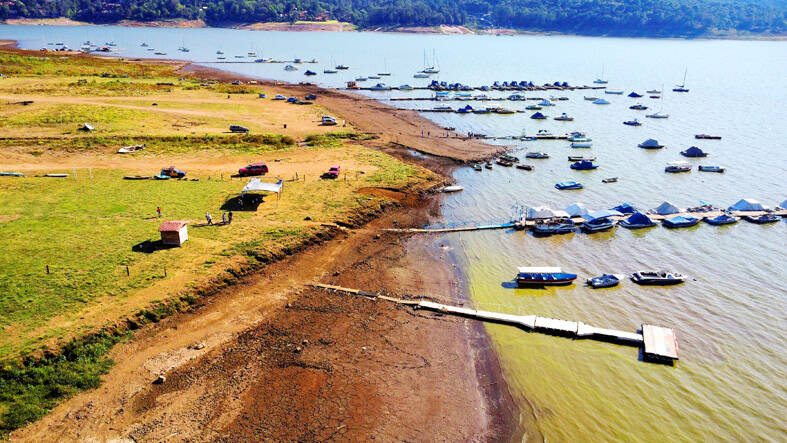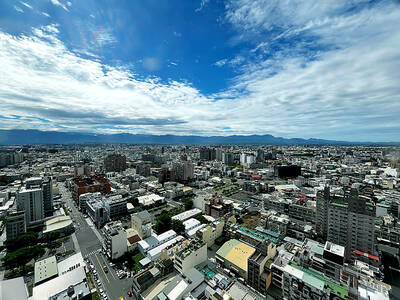The shores of the giant dam in Valle de Bravo, a popular weekend spot for Mexico City’s rich and famous, have turned to cracked, dry mud.
Mario Garcia, a boat driver of more than 30 years, pointed to a red truck in the distance about 100m away and said that was where the shores used to begin.
The dam is at less than 32 percent of its capacity, a historic low, according to available government data, experts and local officials.

Photo: Reuters
Valle de Bravo’s dam feeds the Cutzamala System, a network of infrastructure that is the source of water for about 6 million people two hours away in Mexico City and the surrounding area. It is dealing with a sharp decline in its levels as it strains to quench a growing population amid dwindling rainfall.
Meanwhile, hundreds of full artificial lakes and dams, including some that serve no other purpose than aesthetic enhancement, are in the sprawling walled properties belonging to the upper echelon of Mexican society all around the area, the city’s municipal president and local residents say.
Like many who earn money from tourism, Garcia’s income has dropped considerably as the dam’s levels are too low to take tourists out skiing or even the daily fishing that used to provide for his family.
As some neighborhoods in Mexico City have been without water for weeks, these private bodies of water in Valle de Bravo have emerged as a symbol of inequitable access that angers many people in the tourism-reliant community.
The flash point comes as tensions around water scarcity increase across Mexico, with heavy water users such as factories and high-end tourist resorts coming under scrutiny. Protesters from Valle de Bravo this month blocked traffic near offices of Mexico’s National Water Commission (Conagua) in Mexico City.
Other factors are also contributing to the water woes. Years of dwindling precipitation, rapid development and deforestation have drained local rivers, streams and waterfalls, which lead to the dam.
Progressively lower rainfall puts Valle de Bravo’s dam under unsustainable pressure — with a deficit of 12.8 percent last year during drought conditions sparked by La Nina climate phenomenon, National Autonomous University of Mexico researcher Jorge Ramirez-Zierold said.
In the nearby community of Acatitlan, the natural spring El Crustel, an important source of drinking water, has about half the flow it did 40 years ago, locals say, blaming diversions on residents using excessive amounts to water their grass or gardens.
“I wish [private lakes] didn’t exist,” said Eduardo Maza, a member of the local organization Communities Organized for Water. “But if they do exist, they should be done properly and without harming others.”
When responsibly managed, private lakes and dams can increase biodiversity by attracting birds and animals, said Jose Rosas, a permaculture expert who has designed systems for many of the area’s ranch owners.
“I’m not telling you that they don’t have bad points, surely they do,” said Rosas, who estimates private lakes account for less than 1 percent of the dam’s capacity. “But the environmental benefits are much greater.”
It’s difficult to calculate the effect these private bodies of water have on the community’s resources, Valle de Bravo Municipal President Michelle Nunez said.
She provided pages of satellite images her office has compiled of hundreds of lakes on private properties, which she said have been shared with Conagua.
There are no permits or authorizations for these bodies of water, Nunez said.
She wants owners of private lakes to submit to inspections to prove they are capturing rainwater and not illegally diverting local sources.
“It is very selfish ... to have those lakes at those levels when there are families that depend 100 percent on income [from the dam] that are being extremely affected,” Nunez said.
She cannot act without federal support from Conagua, which she said has done no studies and given no response to her complaints.
A Conagua spokesman did not respond to multiple requests for comment for this story.
The Citizen Observatory of the Valle de Bravo basin, a local residents group, last year filed a petition against Mexico’s government under the Commission for Environmental Cooperation, which oversees environmental issues in the North American trilateral trade pact.
For locals like Maza, who has spent his life working with the area’s water sources, change would be a major challenge, especially when communication between rich property owners and local communities does not exist, he said.
“Either they arrive by helicopter or they arrive with six or seven trucks, and they pass by without stopping and don’t even notice anything,” Maza said.

BYPASSING CHINA TARIFFS: In the first five months of this year, Foxconn sent US$4.4bn of iPhones to the US from India, compared with US$3.7bn in the whole of last year Nearly all the iPhones exported by Foxconn Technology Group (富士康科技集團) from India went to the US between March and last month, customs data showed, far above last year’s average of 50 percent and a clear sign of Apple Inc’s efforts to bypass high US tariffs imposed on China. The numbers, being reported by Reuters for the first time, show that Apple has realigned its India exports to almost exclusively serve the US market, when previously the devices were more widely distributed to nations including the Netherlands and the Czech Republic. During March to last month, Foxconn, known as Hon Hai Precision Industry

Taiwan Semiconductor Manufacturing Co (TSMC, 台積電) and the University of Tokyo (UTokyo) yesterday announced the launch of the TSMC-UTokyo Lab to promote advanced semiconductor research, education and talent development. The lab is TSMC’s first laboratory collaboration with a university outside Taiwan, the company said in a statement. The lab would leverage “the extensive knowledge, experience, and creativity” of both institutions, the company said. It is located in the Asano Section of UTokyo’s Hongo, Tokyo, campus and would be managed by UTokyo faculty, guided by directors from UTokyo and TSMC, the company said. TSMC began working with UTokyo in 2019, resulting in 21 research projects,

Taiwan’s property market is entering a freeze, with mortgage activity across the nation’s six largest cities plummeting in the first quarter, H&B Realty Co (住商不動產) said yesterday, citing mounting pressure on housing demand amid tighter lending rules and regulatory curbs. Mortgage applications in Taipei, New Taipei City, Taoyuan, Taichung, Tainan and Kaohsiung totaled 28,078 from January to March, a sharp 36.3 percent decline from 44,082 in the same period last year, the nation’s largest real-estate brokerage by franchise said, citing data from the Joint Credit Information Center (JCIC, 聯徵中心). “The simultaneous decline across all six cities reflects just how drastically the market

Ashton Hall’s morning routine involves dunking his head in iced Saratoga Spring Water. For the company that sells the bottled water — Hall’s brand of choice for drinking, brushing his teeth and submerging himself — that is fantastic news. “We’re so thankful to this incredible fitness influencer called Ashton Hall,” Saratoga owner Primo Brands Corp’s CEO Robbert Rietbroek said on an earnings call after Hall’s morning routine video went viral. “He really helped put our brand on the map.” Primo Brands, which was not affiliated with Hall when he made his video, is among the increasing number of companies benefiting from influencer